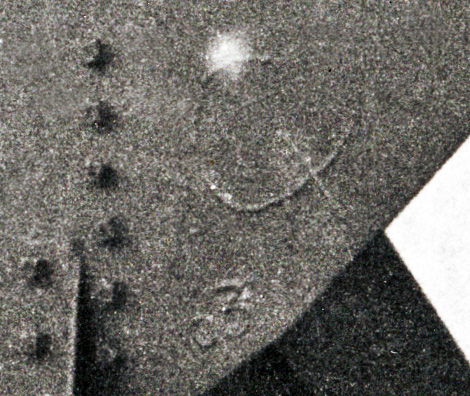Portrait un-retouching
A few weeks ago, I was given a photograph to digitize – a pretty standard request in DPS. The photograph is a portrait of Alexander Nesbitt, co-founder (with his wife Ilse Buchert Nesbitt) of the Third & Elm Press; the Brown University Library has a sizeable archive that includes “art and design work from the Third & Elm Press; in part, joint art and design work of Alexander Nesbitt and Ilse Buchert Nesbitt for other than Third & Elm; and in part the papers of Alexander Nesbitt, including correspondence, writings, miscellaneous papers, academic papers, non-academic lectures, biographical/personal materials, and museum objects” (from Brown University Library catalog record).
 It’s a lovely portrait, and one of the only portraits of him from that time period. The only problem? At some point, the image was retouched to mask out a large area around Mr. Nesbitt’s face – giving this unusual halo effect that proved very distracting. Normally, our archival digitization workflows aim only to capture the originals as accurately as possible, but this was a special case for this particular collection, so we decided that we would keep two copies of the scan that I’d made. We kept one version that included the original retouching, and a new version where I eliminated the halo, and attempted to recreate as best as possible the image underneath. We would add both versions to the Brown Digital Repository, and also wanted to be able to make new prints of the image – printed using archival processes and fine art papers – that we could use for display to protect the original from damage.
It’s a lovely portrait, and one of the only portraits of him from that time period. The only problem? At some point, the image was retouched to mask out a large area around Mr. Nesbitt’s face – giving this unusual halo effect that proved very distracting. Normally, our archival digitization workflows aim only to capture the originals as accurately as possible, but this was a special case for this particular collection, so we decided that we would keep two copies of the scan that I’d made. We kept one version that included the original retouching, and a new version where I eliminated the halo, and attempted to recreate as best as possible the image underneath. We would add both versions to the Brown Digital Repository, and also wanted to be able to make new prints of the image – printed using archival processes and fine art papers – that we could use for display to protect the original from damage.
The photograph itself was also showing some aging and use problems: there were some minor color shifts in the photograph (the sepia-ish light brown tone was turning to yellow-orange in the highlights), and there were some bends and tears in the paper. I was able to correct those relatively easily using straightforward image processing techniques. I also removed some dust and scratches from the original printing. Then, I moved on to the main job: removing the while halo, and recreating all the areas underneath the white mask. This was relatively easy to do when it came to the background, but when it came to Mr. Nesbitt’s neck, suit, shirt, and tie, it was far more challenging to recreate an accurate and convincing image.
I was able to determine how to recreate the tie relatively easily – I did basic image searches for men’s ties and tried to find some good matches to work from. The shirt and coat lapels were trickier, because they’re a specific style. The coat lapels in particular required a little more investigation, especially to get the notch correct and to make sure the angles and spread looked right. Here, my research led me to Hollywood:

Left: Screenshot from Indiana Jones and the Temple of Doom, © 1984 Lucasfilm, Ltd. Right: Still from The King’s Speech, © 2010 The Weinstein Company.
I used these images from Indiana Jones and the Temple of Doom (1984) and The King’s Speech (2010) as guides in recreating the suit jacket for Mr. Nesbitt. I did not use the images to add to the file I was working on; rather, I used them as reference as I recreated the lines, textures, and shadows of the jacket through various processing techniques. When retouching was complete, we had prints made of both images: the original with basic color adjustments and tear repairs, and the fully retouched version with the halo removed. Here’s the before and after, from raw scan to completed file:








